A Vegetable to Root For
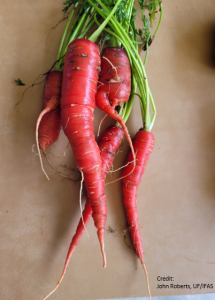
There are many iconic vegetables, but few are as bold as the bright orange carrot – the champion of root vegetables in terms of taste and popularity. And sure, tomatoes are the hallmark of a green thumb gardener, but carrots are the low-hanging fruit for low-key flexing your gardening prowess… in fact, they’re so low, they’re below the surface of the earth. Although basements are typically impractical for most Florida homeowners, subterranean carrot roots are not, and should be encouraged based on their ease of propagation and high nutritional content. Packed with vitamin A (i.e., via beta-carotene) while also providing other vitamins, antioxidants, and dietary fiber, carrots make a great addition to a daily diet. Another positive trait is that, with refrigerator assistance, garden carrots can store for months past harvest.
When to plant in Central Florida: August-March
Seed depth: 0.5 inch
Spacing: 1-2 inches between plants and 18-24 inches between rows
Days until harvest: 70-120 days
How to prepare: highly versatile – raw, salads, soups, steaming, frying, juicing, blending, preserves, puddings, cakes, etc.
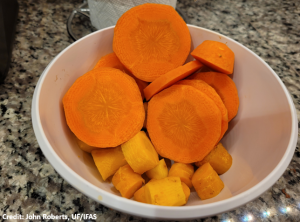
Carrots are tough. They don’t require plant “pre-school” like tomatoes, peppers, many herbs, and cruciferous plants that benefit from a tender upbringing prior to transplanting. Most root plants are more resilient to direct sowing, so carrots are a good crop candidate if avoiding “starts” is an objective. After sowing, UF/IFAS recommends 70 to 120 days from planting to harvest, but generally, longer is better for larger carrots. This make sense since carrots outside of domestication are biennial plants with a lifecycle that focuses on vegetative growth (i.e., leaves, roots, etc.) and the storage of energy in the first year and the production of flowers and seeds in the second year. This trait has made them ideal for harvest after the first year’s cycle, ideally while the roots are sizeable yet still crisp and not excessively tough. In Central Florida, it is best to keep in mind that carrots are considered a cold season vegetable and will have difficulty tolerating the warmest months of the year, so sowing should be done between the months of August through March.
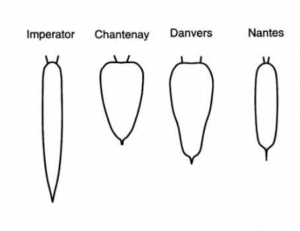
Although the common portrayal of the carrot is orange, this a relatively modern convention that can be traced back to the Netherlands in the 1600s. Prior to this, carrot roots likely had an ancestral form that tended to branch, have more root hairs, and typically ranged in color from yellow to purple. Eastern carrots in cultivation through modern-day Iran, Afghanistan, and India are likely more similar to the predecessors that led to the contemporary orange carrot. Some western carrot types (i.e., a group of similar cultivars) of note include Chantenay, Danvers, Imperator, and Nantes. Imperator types tend to have a high sugar content, store well, and are therefore the most commercially available type of carrot. However, when there is a rainbow of cultivation possibilities out there, many vegetable gardeners have begun tapping into the eastern

carrot gene pool for spectacular prismatic harvests that would have been uncommon in most North American vegetable gardens a generation prior. Keep in mind that not all of these plants will have the same traits. In particular, purple carrots like ‘black nebula’ can astound with its darkness, but relative to many of the conventional orange carrots, they have a lower shelf life, higher prevalence of root hairs, and a propensity to bleed anthocyanins that turns dishes various hues of purple (although, this could be big hit if you are preparing food for a Prince themed birthday party). As for the yellow and red carrots, they are more similar to the orange carrots, but with a more subdued “carrot flavor” with good crispness and sweetness.
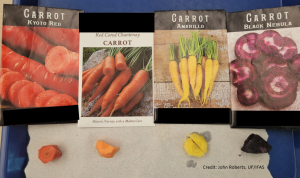
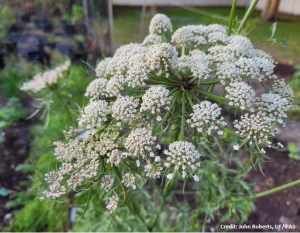
Every part of the carrot is often overlooked relative to the root. The leaves can be eaten as microgreens. If allowed to flower, they produce delicate white or creamy colored blooms that have their own horticultural merit. Undomesticated carrots are sometimes propagated just for their flowers, which are known as “Queen Anne’s lace.” Eventually these flowers will dry-up and the fruit cluster can potentially turn into a tumbleweed that can carry and disperse the seeds via wind-driven locomotion. Much like the onion, the carrot also has an edible wild cousin in North America that tends to be much smaller than the domestic variety. However, foraging is best left to the experienced since there are a few poisonous plants that have similar appearances (i.e., poison hemlock). Please use caution while engaging in Bear Grylls/Survivor Man pursuits – it is completely unnecessary to suffer the fate of Socrates over erroneous herb identification. It might be better to stick to garden variety carrots with known provenance given the many merits of this colorful soil-dweller.
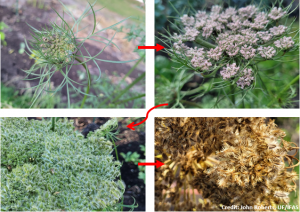
Resources:
Wikipedia page on carrots
Carrots – UF/IFAS Gardening Solutions
Florida Vegetable Gardening Guide via UF/IFAS – EDIS
My website
 0
0
